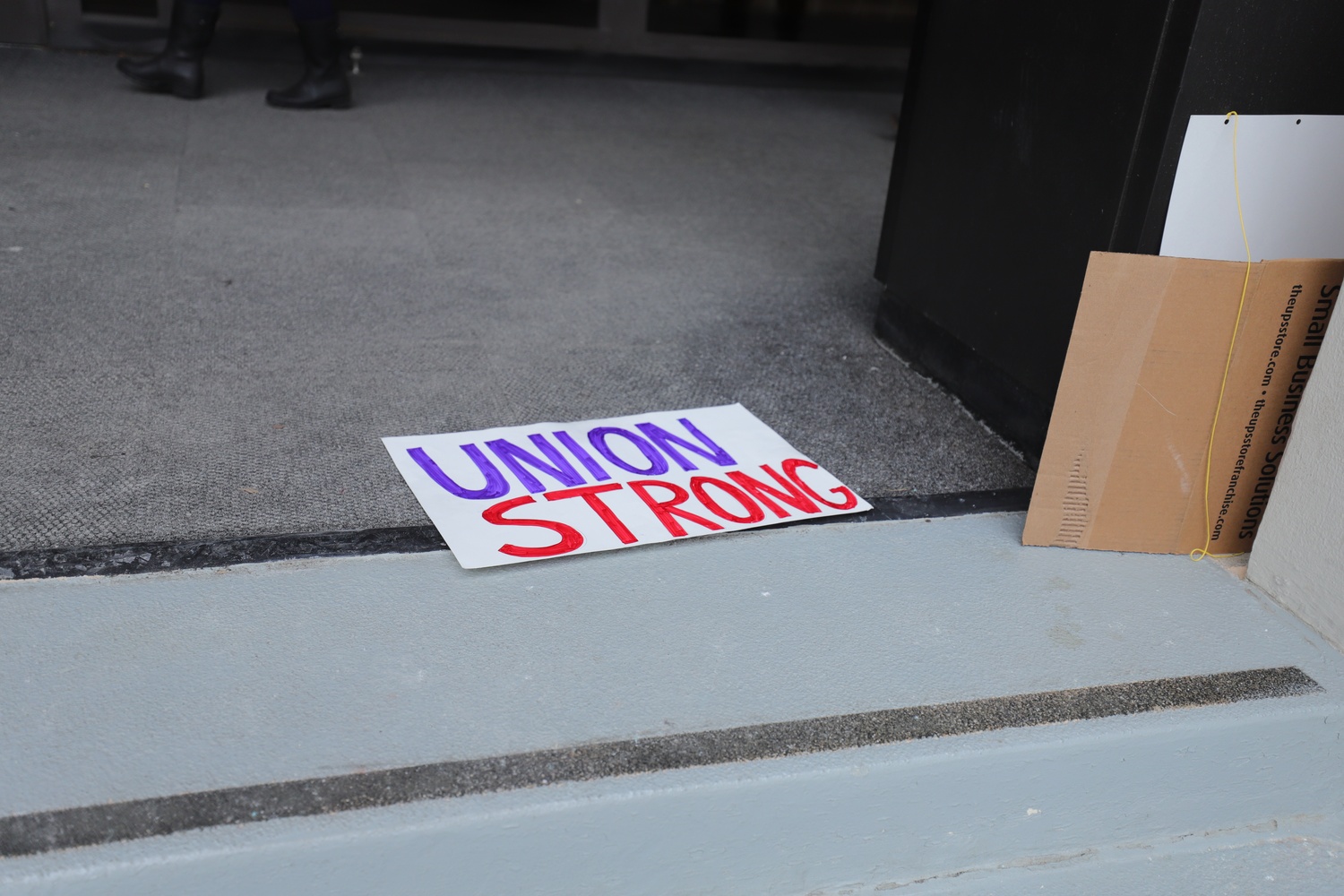‘Harder for All of Us’: Confusion Reigns After Harvard Excludes 900 Grad Students From Union
Harvard removed more than 900 students on research-based stipends from representation under its graduate student union in July. More than a month later, they’re still searching for clarity — and getting few answers.
Lindsey E. Adams, a Ph.D. student in Harvard’s virology program, opened her pay stub on July 1 to a strange sight: Her research stipend was no longer listed as a union stipend, and no union dues were deducted from her pay.
But nothing about Adams’ job was different — not her hours, not her supervisor, not the lab where she works or the tasks she completes every day.
“My work day-to-day has not changed at all,” she said.
Adams was one of the more than 900 students on research-based stipends removed from Harvard’s graduate student union’s bargaining unit in July shortly after the union’s second contract with the University expired. Without union representation, the students are not entitled to contract protections, including union benefits, access to union funds, and the pay raises that the union is negotiating for in its third contract.
Now, more than a month after the students’ removal, the Harvard Graduate Student Union-United Automobile Workers and its workers are still trying to understand the University’s criteria for excluding certain students — who it claims are not employees — and examining whether they have a path to appeal the decision.
Under different circumstances, the union might contest the students’ removal by filing an unfair labor practice charge with the National Labor Relations Board. But under the Trump administration, the risks of that approach might outweigh the rewards.
As President Donald Trump readies two Republican nominees to the five-member board, which would tilt it to a Republican majority, a case involving student workers could be used to eliminate students’ right to unionize. Such a decision would be a near certainty, according to Boston University labor law professor emeritus Michael C. Harper.
While the union has not ruled out a ULP altogether, they have started by going through the grievance procedures outlined in their contract.
Officials filed a grievance against Harvard on July 21 and a request for information on July 30. The grievance alleges that the students’ removal caused a slew of contract violations, including under articles related to the composition of the bargaining unit and worker classifications.
The union also alleges that the students’ removal violates the union security clause of their current contract with the University, which facilitates automatic paycheck deductions for union dues. According to HGSU-UAW financial secretary Simon A. Warchol, a Computer Science Ph.D. student, the union could lose anywhere from 25 to 40 percent of the dues that Harvard automatically deducts from workers’ paychecks each month.
“We believe this violates not just the unit definition that we have in the contract, but the union definition that we have operated on ever since we’ve had the first elections whose results were certified by the NLRB,” HGSU-UAW vice president Sudipta Saha said. “They very explicitly say that all research assistants are included, regardless of funding source, and the University has decided to kind of unilaterally change their interpretation.”
The University has maintained that the excluded students are not employees covered by the contract. Nonemployees would not receive contract protections in the first place, making their funding source irrelevant.
The union held a meeting with Harvard officials on Aug. 4 under Step One of the grievance process in their contract. In an official response to the union after the meeting, Director of Labor and Employment Relations Brian Magner dismissed the grievance, writing that “the University finds no contractual violation has occurred and therefore the grievance is denied.”
The HGSU-UAW can escalate the grievance to Step Two of its process. If Harvard once again rejects the union’s claims, the HGSU-UAW will then have to seek arbitration to continue pursuing the grievance.
But Harvard is likely to say that the issue is not arbitrable. In his Step One response, Magner said that because Harvard took action after the union’s contract expired on June 30, the status of the removed students is not subject to arbitration.
The union has argued that Harvard acted before the expiration because student pay stubs on July 1 already showed a change in union representation — which could make the issue arbitrable.
Harvard has said that stipended students’ research doesn’t count as employment because it helps them work toward their degrees — and because they aren’t performing specific tasks in exchange for compensation. But some labor scholars have said they find the reasoning implausible.
Harvard Law School professors Sharon Block, Benjamin I. Sachs, and Laura M. Weinrib ’00 wrote in an article published in OnLabor, a labor relations blog, that Harvard’s rationale for the students’ removal “runs counter to recent history in the law and at Harvard.” They added that Harvard’s reliance on a 2024 decision excluding stipended fellows from MIT’s graduate student union did not necessarily justify the Harvard students’ removal.
While the three lawyers wrote that determining the Harvard students’ correct classification would depend on a number of factual questions about their work, they concluded that “it would be surprising, in other words, if no Harvard graduate student who receives a stipend does any work that is controlled by Harvard.”
A Harvard spokesperson declined to comment for this article, instead referring to Magner’s statement and the HGSU-UAW’s contract.
The union has also begun circulating an open letter calling on Harvard to reverse the student removals and “respect the outcome of past arbitrations” on the status of lab-based psychology students, which required Harvard to include them in the HGSU-UAW’s bargaining unit. As of Thursday, the letter had accrued 159 signatures from Harvard affiliates.
In the meantime, both students and the union are trying to establish whether there was a pattern among the removals. According to Saha, the University has not answered questions from the union, instead referring them back to the July 2 email announcing the change in classification. The union has had to cross-compare worker lists before and after the email to see who was removed.
More than half of the impacted students are in Harvard Medical School’s Division of Medical Sciences, according to two union officers. Many first- and second-year Ph.D. students, who are usually funded by the Division of Medical Sciences or by National Institutes of Health grants, have been removed from the unit.
For third-years and above, the removals become more difficult to parse because higher-level HMS students may receive funding from several streams and work under principal investigators with several institutional affiliations.
Laila B. Norford, a union steward for DMS graduate students and third-year Ph.D. student in biomedical informatics who was removed from the union, said that most students in hospital-based or hospital-affiliated labs have been removed, as have those fully funded on fellowships. Adams said she was likely removed from the unit because her PI, Daniel Lingwood, holds a secondary appointment at Mass General Hospital’s Ragon Institute.
Still, a number of questions remain. Students may also be funded by sources in addition to their stipends. According to Norford, these workers have been partially removed from the union — union dues have been automatically deducted only from their non-stipended pay.
Most student workers do not hold teaching positions over the summer, making term-time calculations of the total number of affected students difficult to predict.
“It seems very arbitrary,” said Albert T. Chen, a fourth-year student in the Biomedical and Biological Sciences program and HGSU-UAW bargaining committee member who was removed from the bargaining unit. “There’s some workers that are doing the same work, in the same labs, in the same program. Some are being carved out, some aren’t.”
Faced with a slew of questions from students, DMS executive director Samantha Reed — a member of Harvard’s bargaining committee during negotiations with the HGSU-UAW — sent an email on July 25 to all DMS students reiterating much of the University’s July 2 message.
Reed added that workers within the bargaining unit would be paid biweekly and would not see an increase in salary over last year because of ongoing union negotiations. Because non-union students may be paid monthly, students have been able to use their pay periods to help determine whether they are still part of the HGSU-UAW.
Norford said that the lack of communication from the University has compounded an already existing crisis in the sciences as workers are buffeted by federal funding cuts.
“It’s just kicking the scientists while we’re down,” Norford said. “We’re already suffering and struggling so much because of what the federal government is doing, but also because of how Harvard’s responding to it. And now what they’re doing in this moment is trying to make it harder for all of us.”
—Staff writer Amann S. Mahajan can be reached at amann.mahajan@thecrimson.com. Follow her on X @amannmahajan.
